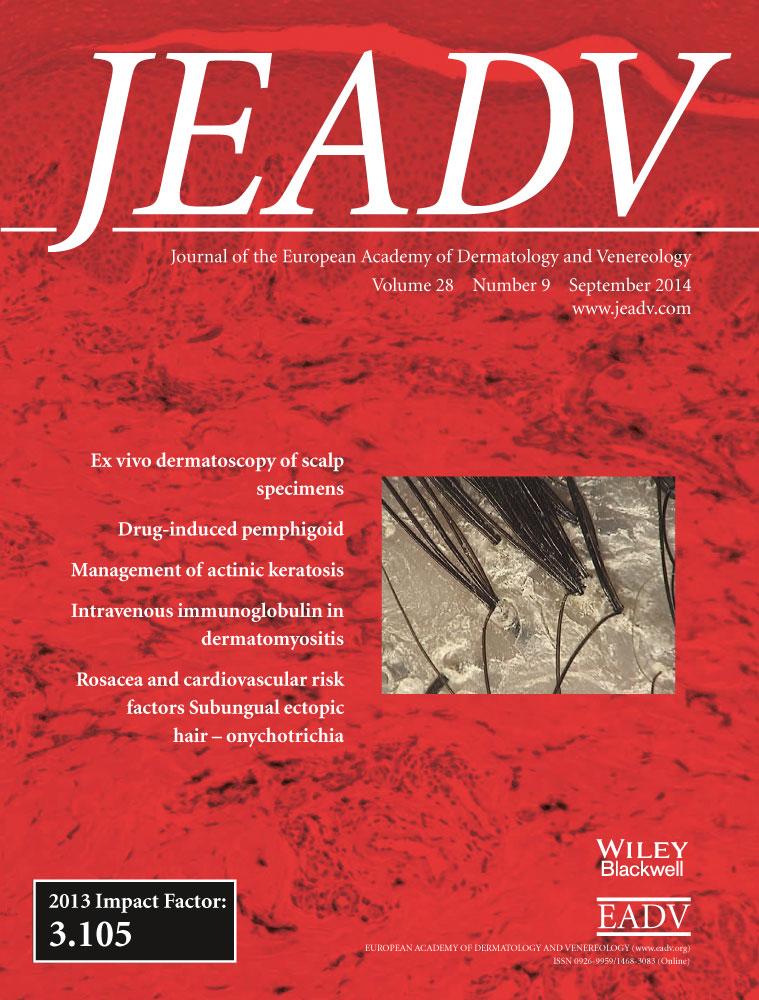Kimura's disease with prurigo lesions treated with systemic indomethacin
Corresponding Author
T. Hashimoto
Department of Dermatology, National Defense Medical College, Tokorozawa, Japan
Department of Dermatology, Graduate School, Tokyo Medical and Dental University, Tokyo, Japan
Correspondence: T. Hashimoto. E-mail: [email protected]Search for more papers by this authorT. Satoh
Department of Dermatology, National Defense Medical College, Tokorozawa, Japan
Search for more papers by this authorA. Furuya
Department of Dermatology, National Defense Medical College, Tokorozawa, Japan
Department of Dermatology, Graduate School, Tokyo Medical and Dental University, Tokyo, Japan
Search for more papers by this authorN. Kataoka
Department of Dermatology, Graduate School, Tokyo Medical and Dental University, Tokyo, Japan
Search for more papers by this authorH. Yokozeki
Department of Dermatology, Graduate School, Tokyo Medical and Dental University, Tokyo, Japan
Search for more papers by this authorCorresponding Author
T. Hashimoto
Department of Dermatology, National Defense Medical College, Tokorozawa, Japan
Department of Dermatology, Graduate School, Tokyo Medical and Dental University, Tokyo, Japan
Correspondence: T. Hashimoto. E-mail: [email protected]Search for more papers by this authorT. Satoh
Department of Dermatology, National Defense Medical College, Tokorozawa, Japan
Search for more papers by this authorA. Furuya
Department of Dermatology, National Defense Medical College, Tokorozawa, Japan
Department of Dermatology, Graduate School, Tokyo Medical and Dental University, Tokyo, Japan
Search for more papers by this authorN. Kataoka
Department of Dermatology, Graduate School, Tokyo Medical and Dental University, Tokyo, Japan
Search for more papers by this authorH. Yokozeki
Department of Dermatology, Graduate School, Tokyo Medical and Dental University, Tokyo, Japan
Search for more papers by this author
References
- 1Ishiguro N, Shishido E, Okamoto R, Igarashi Y, Yamada M, Kawashima M. Ofuji's disease: a report on 20 patients with clinical and histopathologic analysis. J Am Acad Dermatol 2002; 46: 827–833.
- 2Hirai H, Tanaka K, Takano S, Ichimasa M, Nakamura M, Nagata K. Cutting edge: agonistic effect of indomethacin on a prostaglandin D2 receptor, CRTH2. J Immunol 2002; 168: 981–985.
- 3Hirai H, Tanaka K, Yoshie O et al. Prostaglandin D2 selectively induces chemotaxis in T helper type 2 cells, eosinophils, and basophils via seven-transmembrane receptor CRTH2. J Exp Med 2001; 193: 255–261.
- 4Kataoka N, Satoh T, Hirai A, Saeki K, Yokozeki H. Indomethacin inhibits eosinophil migration to prostaglandin D2: therapeutic potential of CRTH2 desensitization for eosinophilic pustular folliculitis. Immunology 2013; 140: 78–86.
- 5Satoh T, Shimura C, Miyagishi C, Yokozeki H. Indomethacin-induced reduction in CRTH2 in eosinophilic pustular folliculitis (Ofuji's disease): a proposed mechanism of action. Acta Derm Venereol 2010; 90: 18–22.
- 6Nomura K, Sasaki C, Murai T, Mitsuhashi Y, Sato S. Angiolymphoid hyperplasia with eosinophilia: successful treatment with indomethacin farnesil. Br J Dermatol 1996; 134: 189–190.
- 7Gambichler T, Luther H, Bararach-Buhles M, Altmeyer P, Stucker M. Generalized Kimura's disease masquerading as nodular prurigo. Clin Exp Dermatol 2007; 32: 97–99.
- 8Kawada A. Kimura's disease. Demonstration of the disease and its differential diagnosis. Der Hautarzt; Zeitschrift fur Dermatologie, Venerologie, und verwandte Gebiete 1976; 27: 309–317.
- 9Motegi SI, Hattori M, Shimizu A, Abe M, Ishikawa O. Elevated serum levels of TARC/CCL17, Eotaxin-3/CCL26 and VEGF in a patient with Kimura's Disease and Prurigo-like Eruption. Acta Derm Venereol 2013; doi: 10.2340/00015555-1623.
- 10Tabata H, Ishikawa O, Ohnishi K, Ishikawa H. Kimura's disease with marked proliferation of HLA-DR+CD4+ T cells in the skin, lymph node and peripheral blood. Dermatology 1992; 184: 145–148.




